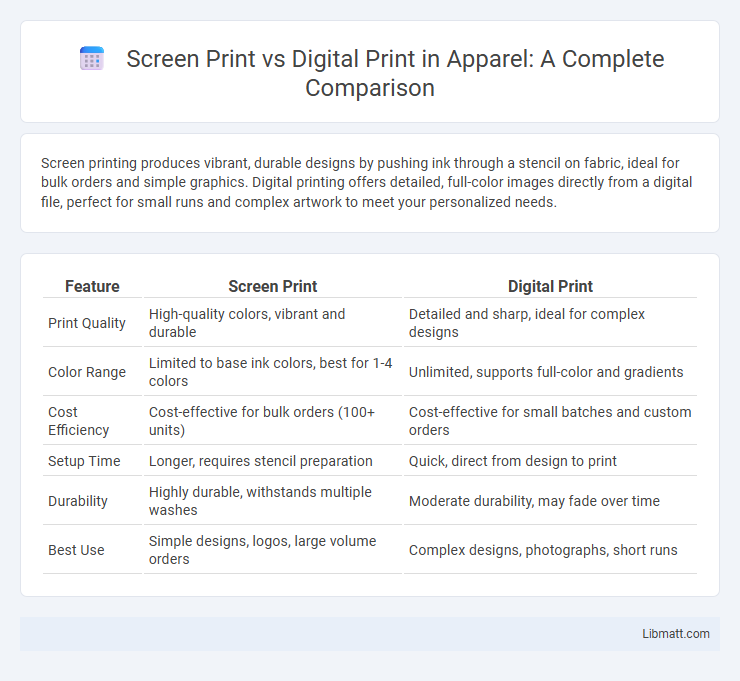Screen printing produces vibrant, durable designs by pushing ink through a stencil on fabric, ideal for bulk orders and simple graphics. Digital printing offers detailed, full-color images directly from a digital file, perfect for small runs and complex artwork to meet your personalized needs.
Table of Comparison
| Feature | Screen Print | Digital Print |
|---|---|---|
| Print Quality | High-quality colors, vibrant and durable | Detailed and sharp, ideal for complex designs |
| Color Range | Limited to base ink colors, best for 1-4 colors | Unlimited, supports full-color and gradients |
| Cost Efficiency | Cost-effective for bulk orders (100+ units) | Cost-effective for small batches and custom orders |
| Setup Time | Longer, requires stencil preparation | Quick, direct from design to print |
| Durability | Highly durable, withstands multiple washes | Moderate durability, may fade over time |
| Best Use | Simple designs, logos, large volume orders | Complex designs, photographs, short runs |
Introduction to Screen Print vs Digital Print
Screen printing uses stencils and ink layers to create vibrant, durable designs ideal for bulk production on textiles and promotional items. Digital printing applies inkjet technology to directly print high-resolution images onto substrates, offering flexibility and rapid turnaround for small quantities. Choosing between screen print and digital print depends on project scale, color complexity, and material type.
Defining Screen Printing
Screen printing is a traditional printing technique that uses a mesh stencil to transfer ink onto a substrate, producing vibrant and durable images ideal for bulk orders. This method excels in creating bold designs with solid colors, making it perfect for custom apparel, posters, and promotional items. Your choice of screen printing ensures long-lasting prints with excellent color opacity and texture.
Understanding Digital Printing
Digital printing utilizes advanced inkjet or laser technology to produce high-resolution images directly from a digital file, enabling faster turnaround times and greater customization. Unlike screen printing, which requires creating stencils and is ideal for large runs, digital printing excels in short runs and detailed color gradients without additional setup costs. Its ability to print variable data makes it perfect for personalized marketing materials and on-demand production.
Key Differences Between Screen and Digital Printing
Screen printing uses stencils and ink layers, making it ideal for large quantities and vibrant, durable designs, especially on fabrics and promotional products. Digital printing directly transfers designs from a digital file onto various materials, offering faster turnaround and more cost-effective options for short runs with intricate, multi-colored graphics. Understanding these key differences helps you choose the best printing method based on project size, complexity, and budget.
Print Quality Comparison
Screen printing delivers vibrant colors and sharp details with excellent durability, making it ideal for designs requiring high opacity on various materials. Digital printing offers superior precision for complex, multi-color images and gradients but may lack the same level of color vibrancy and longevity as screen printing. The choice depends on the specific design requirements and intended use, with screen printing excelling in bold, long-lasting prints and digital printing providing detailed, photo-realistic results.
Cost Analysis: Screen vs Digital Printing
Screen printing typically involves higher upfront costs due to the creation of screens and setup time, making it more cost-effective for large volume orders with consistent designs. Digital printing has lower initial expenses and excels in short runs or highly detailed, multi-colored images, reducing overall costs for small batches or customized prints. Your choice depends on print quantity and design complexity, with screen printing favored for bulk production and digital printing providing flexible, economical solutions for varied or limited runs.
Turnaround Time and Production Speed
Screen printing typically involves longer turnaround times due to setup processes like creating stencils and color separations, making it less ideal for urgent orders. Digital printing offers faster production speeds by eliminating these complex preparations, enabling quick runs and on-demand printing with minimal delays. Your choice depends on whether speed or print volume is the priority, as digital excels in rapid turnaround while screen printing suits larger, consistent batches.
Best Use Cases for Each Printing Method
Screen print excels in producing vibrant, durable designs on bulk orders of textiles, especially for logos and solid colors on t-shirts, hoodies, and promotional apparel. Digital print is ideal for small runs, complex multicolor images, and photo-quality prints on diverse materials, offering quick turnaround with minimal setup costs. Businesses seeking cost-effective customization for personalized items or limited editions benefit most from digital printing, while companies targeting brand consistency through long-lasting, high-volume merchandise prefer screen printing.
Environmental Impact: Screen Print vs Digital Print
Screen printing generates more waste and uses higher volumes of water and chemicals, leading to a greater environmental footprint compared to digital print. Digital printing conserves resources by using less ink and producing fewer emissions, making it a more eco-friendly option for Your sustainable printing needs. Choosing digital print reduces toxic runoff and energy consumption, directly supporting environmental preservation goals.
Choosing the Right Printing Method for Your Project
Screen printing excels in producing vibrant colors and durability for large batches, making it ideal for apparel and promotional items requiring longevity. Digital printing offers a cost-effective solution for small runs and detailed designs, providing quick turnaround with high-resolution output. Understanding project volume, color complexity, and fabric type helps determine whether screen print or digital print delivers the best balance of quality and efficiency.
screen print vs digital print Infographic

 libmatt.com
libmatt.com